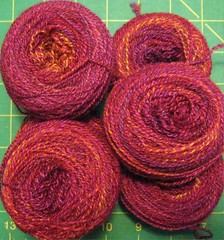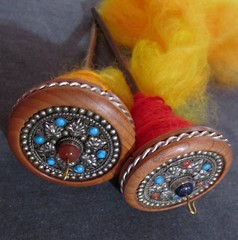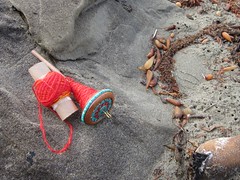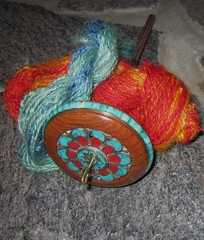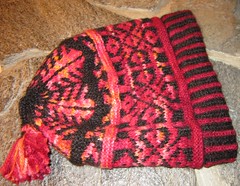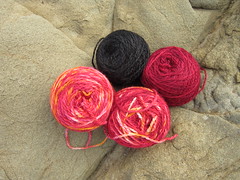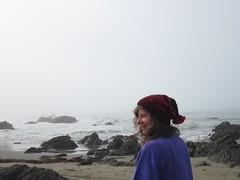Recently, a knitter showed me her current handspun shawl, and expressed concern that it was Not Good Enough. She was hesitant to continue, because there were imperfections. I showed her the shawl I have been working on, which is decidedly
not perfect, and she said Oh. (You have to laugh).
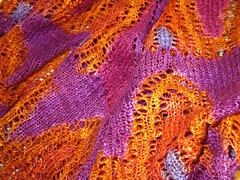
My work is not perfect. It is lovely though, useful, magical, beautiful and wonderful for me to behold. In the process of making things for the last 30+ years, I have learned that to be beautiful, something need not be perfect. The real test is in the
use of a practical object, and it does not have to be
perfect to be useful.
We all worry, second guess our work, step back and criticize. Examination and critical assessment can be a good thing, and is indeed an integral part of mastering a craft. But it can go too far. It can cripple, halt progress, make one run for cover and not finish things.
I might have been known to harp relentlessly on “finishing things”. It’s a problem for many of us, we start something, knitting, spinning, weaving, and it goes along for a while, and then we Stop! And put the work aside, start something else, clean the house (!), go fishing, whatever.
When we finish things, we learn things. We might learn what we never want to do again, but every time we make something, we are teaching our hands and bodies subtle movements that help us master the craft. Sometimes a project is just Proof of Concept, but finishing things is part of mastering the craft. The muscle memory does not come from your head. It comes from doing. Even from doing things Not Perfect. And the muscle memory is the goal: not the thing.
This is not to say we cannot strive for beauty, fine work: perfection, if you will, in what we do. Most craftspeople trying to master their craft are doing just that: striving. But the best of them are not expecting Every Single Work to be Perfect. Not every piece is a Masterpiece. But a masterpiece will not just show up, full blown, the first, second or even third time you do something. It takes work. It takes a body of work, with incremental learning along the way. It takes a visceral and physical understanding of the materials and process in which you choose to work; it requires you to put in the time. The subtle body knowledge that comes from working on your craft has nothing to do with what’s in your head; it’s a muscle memory, and an unconscious knowing without thinking, an integral part of who you are.
Your first (second, third) project should
not be a masterpiece. If so, you have just done something safe, something everyone else has done, something your teacher told you to do, nothing from your heart and soul.You can’t email an internet list and ask how to sett the yarn for a masterpiece. You can’t call up your local weaving teacher and ask which weft to choose. You may get one good piece that way, but will it be yours? Will you have learned the tactile and subtle understanding which makes you a Master of the Craft? Or will you have put together a series of steps to create a beautiful object, One Beautiful Object, with no part of you invested except your head, your intellectual ability to pull together information? That leads to Posing. Posing as a Weaver, because you have woven. Not Being a Weaver (spinner, knitter), but pretending to be one. We even fool ourselves sometimes.
In a recent discussion with several spinners, the topic was “butt to tip, wind off to storage, and ply one direction”, all of which any spinner has heard, and knows the arguments for and against. My question is: are there sweaters made with variations on this theme, worn for ten years and compared??? Can you tell then which was butt to tip, run onto a storage bobbin and plied from the same direction and which was spun more casually? If so, we can all learn. Without the work, it’s just talk. And it is talk that separates, divides people into good and bad spinners, and causes some spinners to halt, paralyzed by
Not Doing it Right, not being perfect.
I want to hear about personal experiences, not listen to a parrot. I want samples, not intellectual exercises. If I keep asking teachers what is the best sock yarn, not spinning sock yarn, knitting socks and deciding for myself, am I a master? If someone asks me for the best cast off to use, do I say Cat Bordhi says
This? Or do I say: "this has worked for me"?

Your teachers should have samples to show you progress, variations from A to B, samples, hopefully, of their own making. Yet even samples of indigenous textiles will help students gain understanding, samples the teacher's apprentice has made will help other seekers. But look for samples, please. We are involved in a tactile craft. The appearance, while important, is not the only criteria for success. Intellectual understanding is not mastery. Performance, over a period of time, is really the goal: beautiful useful objects. To be useful, one need not be perfect.
Machines can make perfect things. That might be why some weavers are attracted to computer weaving: once designed, and set up properly, the machine takes cares of vagaries in memory or order of treadling or complex systems so the fabric structure can be perfect (the weaver still has to provide the information, design, fiber and yarn choices, color choices, even structure choices, to make the fabric beautiful: perfect is not necessarily beautiful. Have I said that enough?).
We should not expect our hands to behave like machines. There lies madness, and the way to piles of unfinished less-than-perfect projects.
When I buy textiles made by hand, I am enchanted to find the little imperfections that indicate a person, not a machine, made what I am holding. Why do we hold ourselves to a different standard? I believe we should glory in the evidence of the human maker, glory in the imperfections, the variations from standard, that make our work, and us, something you cannot buy, something precious in this world, something unique.

Well, I guess I have ranted. Do you wish to rant back? I am curious, and wish to hear it. Please leave a comment, or a link to your post in response.
In the meantime, someone I know practices climbing stairs. She is learning a new muscle memory, and she will be really good at it. Someday.

